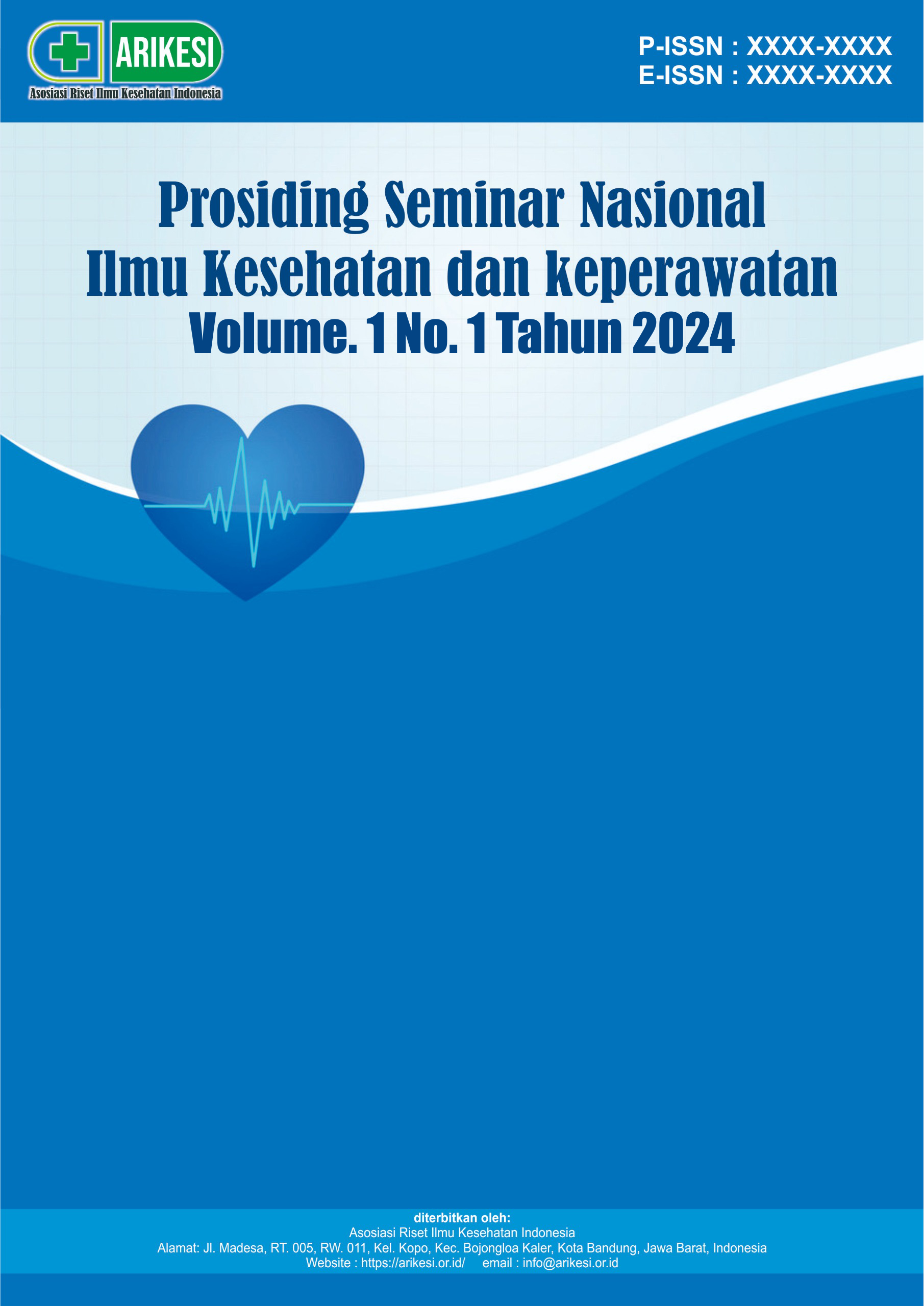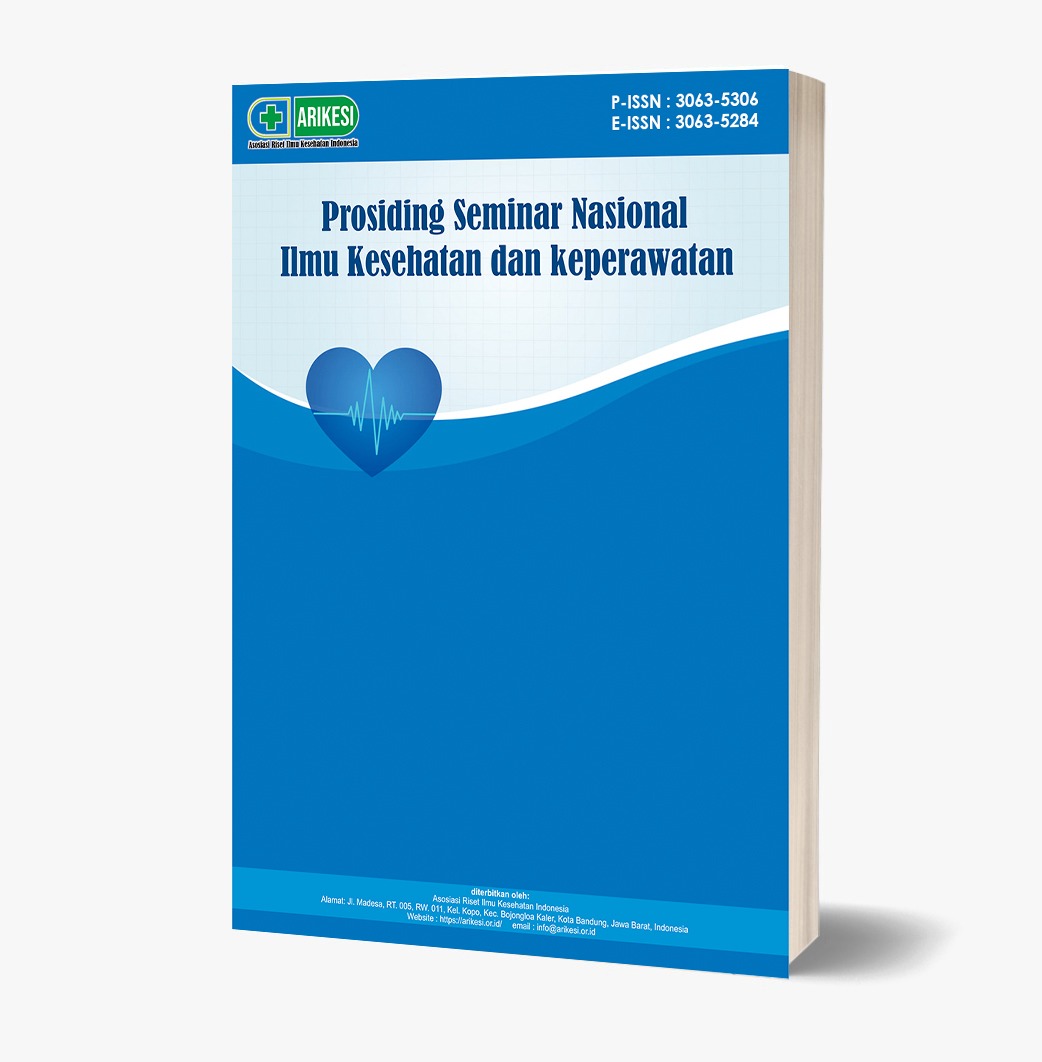Evaluasi Penggunaan Antibiotik Pada Kasus Demam Tifoid Pasien Pediatrik Di Instalasi Rawat Inap Rsu Harapan Ibu Purbalingga Tahun 2022
DOI:
https://doi.org/10.61132/prosemnasikk.v1i1.5Keywords:
Typhoid Fever, Pediatrics, 5T, Evaluation, Rational MedicationAbstract
Typhoid fever is a systemic infection that occurs especially in children due to the compromised state of the immune system and organs are still developing and not perfect. Typhoid fever ranks 4th out of the top 20 pediatric sub-specialty diseases in 2022 and the use of antibiotics that exceed the dose (overdose) at Harapan Ibu Purbalinga Hospital. This research aims to assess the appropriateness of antibiotic treatment in young patients and to review the use of antibiotics in typhoid fever, focusing on accurate diagnosis, appropriate patient selection, appropriate antibiotic selection, correct dosing schedule and optimal duration of treatment (5T). The approach used in this research was the qualitative descriptive technique. The data collection process involved obtaining historical data (medical records) from 100 paediatric inpatients at Harapan Ibu Purbalingga Hospital. The results of this study showed that the gender classification of male patients totaled 55 patients while female patients totaled 45 patients. The age range classification of 1-5 years has the highest number with a percentage of 41%. Antibiotics that are often used are cephalosforin group (72%) while for other classes of antibiotics used for pediatric typhoid fever are penicillin group (28%). When examining the appropriateness of drug use, the results showed that the accuracy of correct diagnoses was 100%, the accuracy of matching patients was 100%, the accuracy of selecting the appropriate antibiotic was 100%, the accuracy of determining dosage was 84%, and the accuracy of determining the correct duration of treatment was 100%.
Downloads
References
Alfina, L. N. R. M. R. (2019). Analisis Perbandingan Antara Monoterapi dengan Dualterapi Antibiotik Extended Empiric pada Pasien Community-Thypoid Fever di RSUP Fatmawati Jakarta. Jurnal Sains Farm Klinis.
Ardiaria, M. (2019). Epidemiologi, Manifestasi Klinis, Dan Penatalaksanaan Demam Tifoid. JNH (Journal of Nutrition and Health), 7(2), 32–37.
Artanti, N. W. (2013). Hubungan Antara Sanitasi Lingkungan, Higiene Perorangan, Dan Karakteristik Individu Dengan Kejadian Demam Tifoid Di Wilayah Kerja Puskesmas Kedungmundu Kota Semarang. UNNES Repository,
Azmatullah, A., Qamar, F. N., Thaver, D., Zaidi, A. K. M., & Bhutta, Z. A. (2015). Systematic Review Of The Global Epidemiology, Clinical And Laboratory Profile Of Enteric Fever. Journal of Global Health, 5(2). https://doi.org/10.7189/jogh.05.020407
Bahtiar, B., Bahtiar, B., Sahar, J., & Wiarsih, W. (2020). Meaning Of Life Among Elderly Individuals With Chronic Diseases Living With Family: A Qualitative Study. Makara Journal of Health Research, 24(1), 35–40. https://doi.org/10.7454/msk.v24i1.1161
Bestari, M. P., & Karuniawati, H. (2017). Evaluasi Rasionalitas dan Efektifitas Penggunaan Antibiotik pada Pasien Demam Thypoid Pediatrik di Instalasi Rawat Inap Rumah Sakit Pusat Jawa Tengah Jurnal Farmasi Indonesia, 4(2), 62–70.
Chandrawati, P. F. (2020). Imunitas Dan Peningkatan Imunitas Pada Anak. Fakultas Kedokteran UMM, 71–83.
Crump, J. A. (2019). Progress in Typhoid Fever Epidemiology. Clinical Infectious Diseases, 68(Suppl 1), S4–S9. https://doi.org/10.1093/cid/ciy846
Elisabeth Purba, I., Wandra, T., Nugrahini, N., Nawawi, S., & Kandun, N. (2016). Program Pengendalian Demam Tifoid di Indonesia: Tantangan dan Peluang. Media Penelitian Dan Pengembangan Kesehatan, 26(2), 99–108.
Global Burden of Disease Collaborative Network. (2020). GBD 2020 Cause and Risk Summaries: Typhoid fever — Level 4 cause. Seattle, United States: Institute for Health Metrics and Evaluation (IHME). 393.
Hanifah, H. Z., Sari, I. P., & Nuryastuti, T. (2018). Evaluasi Penggunaan Antibiotik Empiris dan Analisis Biaya Demam Tifoid di Sebuah RS Swasta Kota Semarang. Jurnal Sains Farmasi & Klinis, 5(1), 1. https://doi.org/10.25077/jsfk.5.1.1-6.2018
Hapsari, T. N. (2019). Evaluasi Penggunaan Antibiotik Pada Pasien Demam Tifoid Di Instalasi Rawat Inap RSUD Dr.R.Soetijono Blora Periode Januari 2017 - Agustus 2018. Universitas Muhammadiyah Surakarta, 1(1), 2–15.
Hayes, J. F. (2022). Fighting Back against Antimicrobial Resistance with Comprehensive Policy and Education: A Narrative Review. Antibiotics, 11(5). https://doi.org/10.3390/antibiotics11050644
IAI. (2022). Informasi Spesialite Obat Volume 54 Tahun 2022. ISSN 854-45, p54, 58–65.
Islami, L. D. N. (2021). Efektivitas Penggunaan Obat Antibiotik Untuk Terapi Demam Typhoid Di Instalasi Rawat Inap RSUD Dr. Soeroto Ngawi. 73.
Kemenkes, RI. (2020). Keputusan Menteri Kesehatan Republik Indonesia Nomor HK.01.07/MENKES/200/2020 Tentang Pedoman Penyusunan Formularium Rumah Sakit. 8(75), 147–154. https://doi.org/10.1016/j.jnc.2020.125798%
Kemenkes, RI. (2021). Pedoman Penggunaan Antibiotik. Pedoman Penggunaan Antibiotik, 1–97.
Kemenkes RI. (2011). Modul Penggunaan Obat Rasional 2011. Modul Penggunaan Obat Rasional, 3–4.
Kemenkes RI. (2014). Profil Kesehatan Indonesia (Demografi). In Kementerian Kesehatan Republik Indonesia (Vol. 51, Issue 6).
Khan, M. (2012). A plausible explanation for male dominance in typhoid ileal perforation. Clinical and Experimental Gastroenterology, 5(1), 213–217.
Lack, J. A., & Stuart-Taylor, M. E. (1997). Calculation of drug dosage and body surface area of children. British Journal of Anaesthesia, 78(5), 601–605.
Lestari, I. D. A. M. D., & Hendrayan, M. A. (2017). Identifikasi dan Diagnosis Infeksi Bakteri Salmonella typhi. Makalah, 32.
Mustofa, F. L., Rafie, R., & Salsabilla, G. (2020). Karakteristik Pasien Demam Tifoid pada Anak dan Remaja. Jurnal Ilmiah Kesehatan Sandi Husada, 12(2), 625–633.
Nonita, R. (2019). Evaluasi Penggunaan Antibiotika Pada Kasus Demam Tifoid Di Rumah Sakit Panti Rini Yogyakarta. Farmasi, 6(1), 42.
Nuruzzaman, H., & Syahrul, F. (2016). Analisis Risiko Kejadian Demam Tifoid Berdasarkan Kebersihan Diri dan Kebiasaan Jajan di Rumah. Jurnal Berkala Epidemiologi, 4(1), 74–86.
Oktaviana, F., & Noviana, P. (2021). Efektivitas Terapi Antibiotika Demam Tifoid Pada. Syifa Sciences and Clinical Research, 3(September), 63–70. http://ejurnal.ung.ac.id/index.php/jsscr,
Pradiningsih, A., Nopitasari, B. L., & Sari, M. (2021). Profil Penggunaan Antibiotik Pada Pasien Demam Tifoid Di Rumah Sakit Umum Daerah Provinsi NTB. Lumbung Farmasi: Jurnal Ilmu Kefarmasian, 2(2), 125. https://doi.org/10.31764/lf.v2i2.5495
Prasad, N., Jenkins, y, A. W. J., Jack, S. J., Saha, D., Horwitz, P., Jupiter, S. D., Strugnell, R. A., Mulholland, E. K., & Crump, J. A. (2018). Epidemiology And Risk Factors For Typhoid Fever In Central Division, Fiji, 2014–2017: A case-control study. 12(6), 2014–2017. https://doi.org/10.1371/journal.pntd.0006571
Pudjiadi, A. H., Hegar, B., Handryastuti, S., Idris, N. S., Gandaputra, E. P., & Harmoniati, E. D. (2009). Pedoman Pelayanan Medis IDAI. Ikatan Dokter Anak Indonesia (IDAI), 25(122), 190–192. https://doi.org/10.1136/adc.25.122.190
Purwaningsih, A. E. D. A., Rahmawati, F., & Wahyono, D. (2015). Evaluasi penggunaan antibiotik pada pasien pediatri rawat inap. Jurnal Manajemen Dan Pelayanan Farmasi, 5(3), 211–218.
Rahmasari, V., & Lestari, K. (2018). Review: Manajemen Terapi Demam Tifoid: Kajian Terapi Farmakologis Dan Non Farmakologis. Farmaka, 16(1), 184–195.
Ray, B., & Raha, A. (2021). Typhoid and enteric fevers in intensive care unit. Indian Journal of Critical Care Medicine, 25(S2), S144–S149. https://doi.org/10.5005/JP-JOURNALS-10071-23842
Rufaie, J. (2021). Evaluasi Rasionalitas Penggunaan Antibiotik Pada Pasien Demam Tifoid Rawat Inap Di RSU Universitas Muhammadiyah Malang Tahun 2019. 26(2), 173–180.
Suria, Y. A. (2021). Evaluasi Pemberian Antibiotik Pada Pengobatan Demam Tifoid Pada Anak Di RSUP Wahidin Sudirohusodo Periode Januari - Desember 2019. 22.
World Health Organization. (2015). World Health Statistics 2015 (WHO Graphics (ed.)). https://doi.org/10.1016/S2214-109X(13)70059-7







